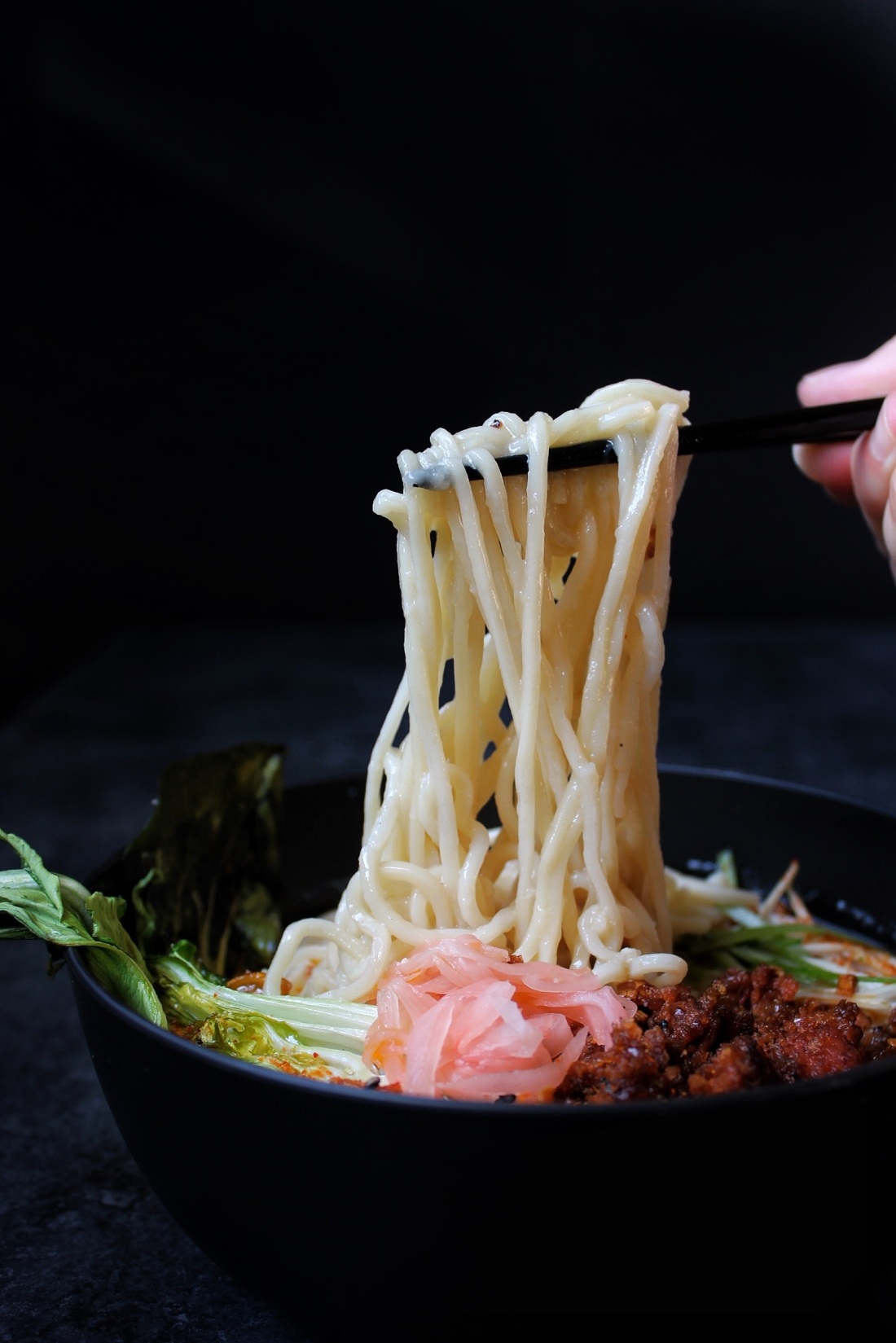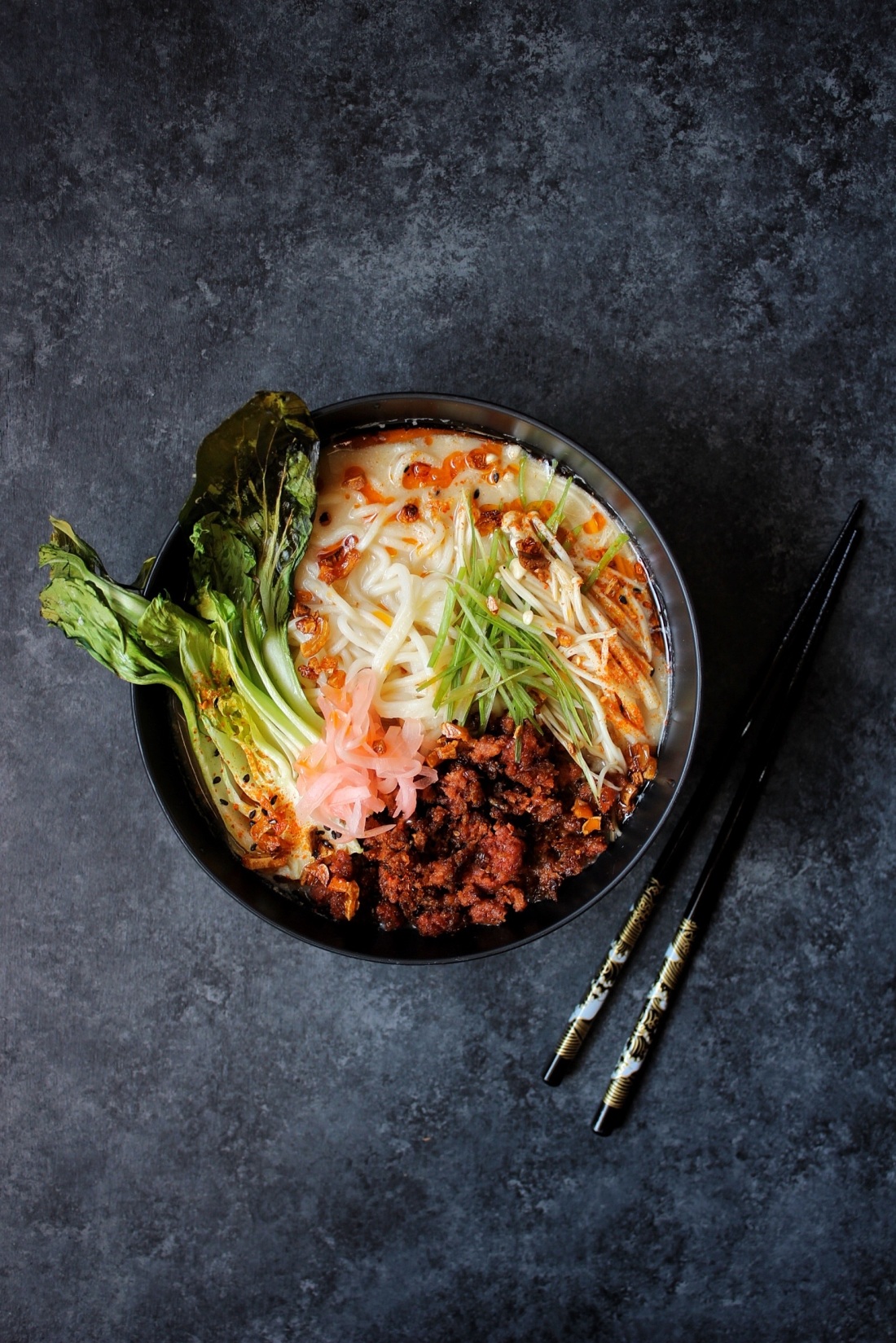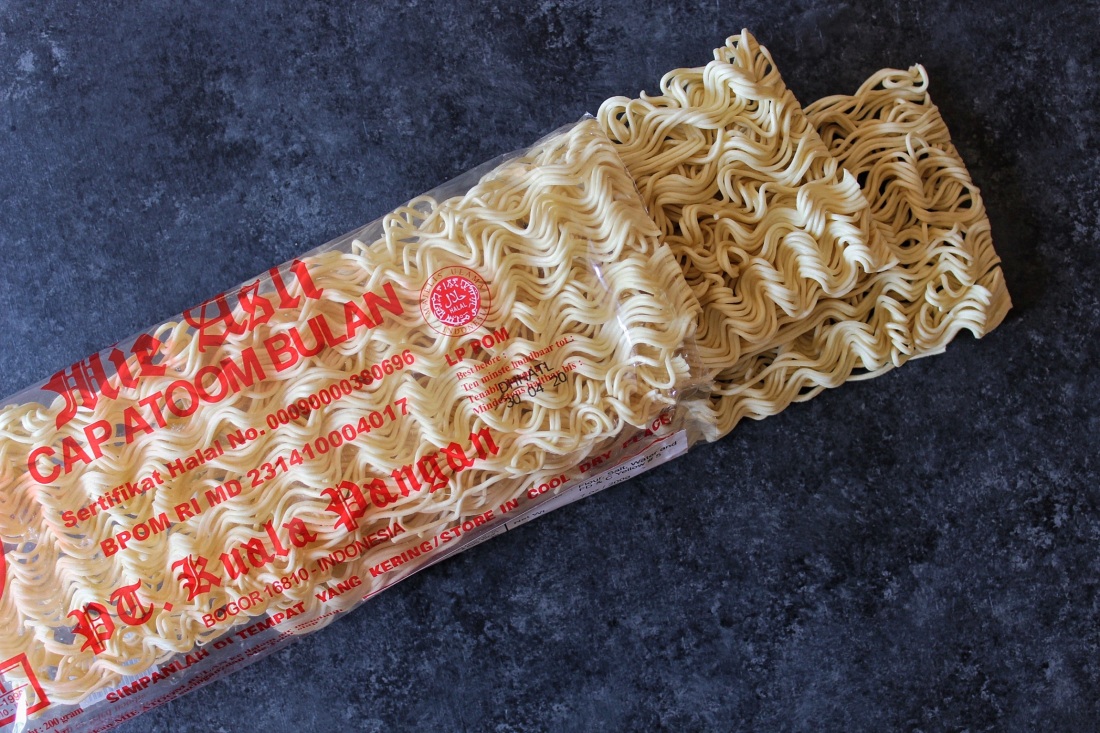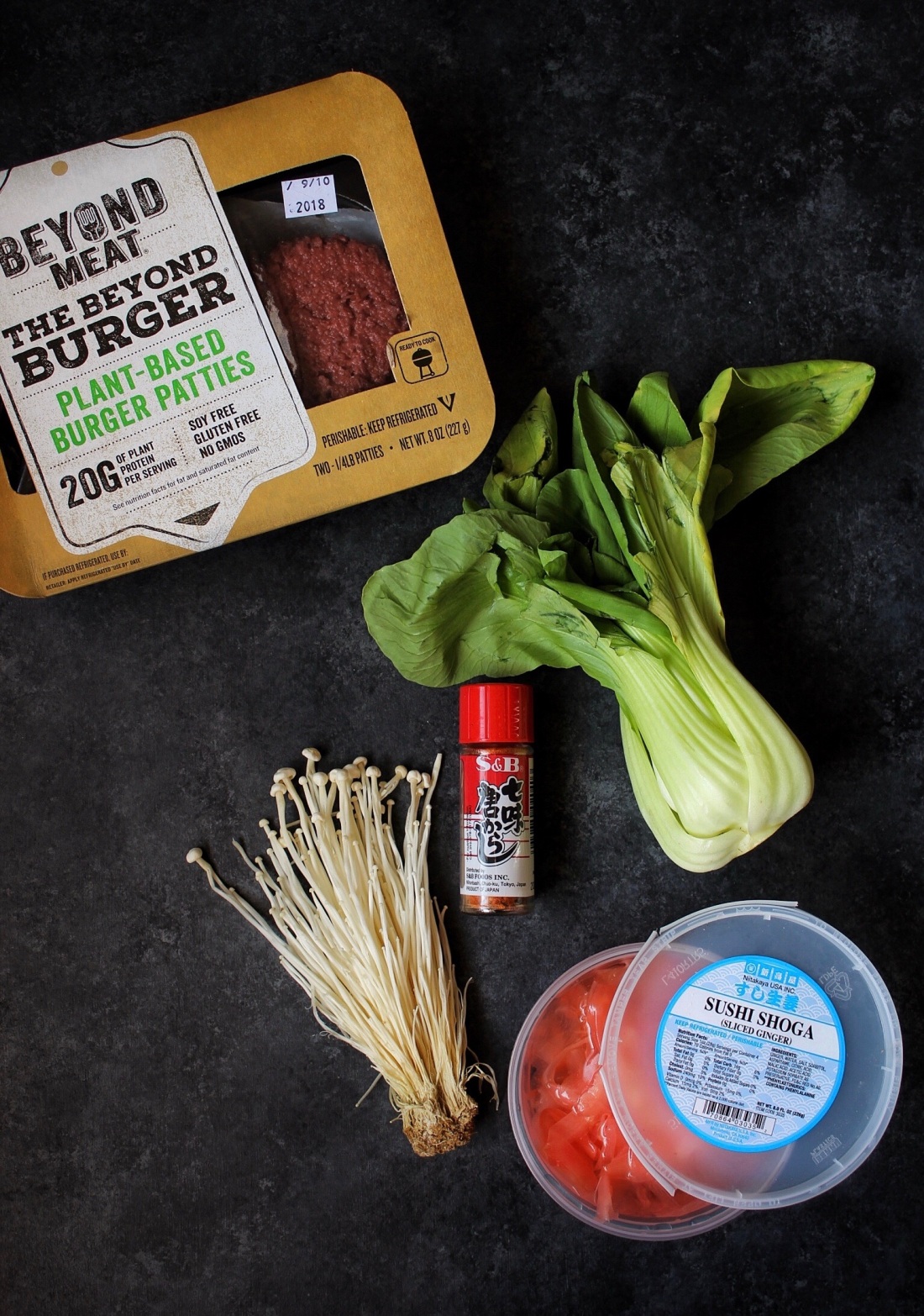In my eyes, ramen is a complicated food. Specifically shaped noodles that are perfectly cooked, broth with such depth it’s almost impossible to tell what it’s made out of, and the right amount of the right kind of toppings that overwhelm neither the noodles or the broth, yet bring new flavors and textures into the experience.
If we’re going to slurp on some quality ramen inside our own home, we’re going to have to do some astute studying.

Let’s tackle the most important thing first: The Broth. It doesn’t matter how good your noodles and toppings are, if the broth is lacking, everything goes down with it. There’s also many styles of broth that can be used for ramen, which can vary from region to time of year to the chef who’s making it. While our broth doesn’t specifically fit any of the categorized styles, it’s most similar to Sapporo Ramen, which features a rich broth (usually made from meat or fish) seasoned with red miso paste and served with thicker noodles that can withstand the thick broth.
There’s not a boxed broth out there that’ll do the trick here, which means we’ve got to make our own (don’t worry – it’s not hard). The base of our broth is made by boiling dried shiitake mushrooms for complexity, umami, and depth, dried seaweed for its ocean-y essence, and a handful of aromatics. Combining dried shiitake with seaweed forms a kind of dashi – traditional Japanese stock used in a plethora of dishes – that’ll lend the soup an undeniable depth.

We wanted to accomplish a broth that has a thick, mouth-coating effect, which is why we turned to soy milk to achieve an almost gravy-like feel. Unfortunately, any soy milk won’t do. The soy milk in question should not be sweetened, flavored with vanilla, or – here’s the kicker – contain no emulsifiers.
Let me explain: there are some soy milks out there with only two ingredients – soybeans and water – which are normally my favorite, but they’re susceptible to curdling when they’re mixed with the hot, slightly acidic broth of this ramen. For that reason, you want to choose a soy milk that contains an additive like guar gum, xanthan gum, or carrageenan, as they will keep the soy milk emulsified even once it’s introduced to the broth. Then, to increase the protein and fat content of the soy milk, we reduce its volume by a third, lending it a creamier body.
Finally, to complete the broth, we add red miso paste, which imparts saltiness, depth, and complexity, and a warmth that’ll uplift your spirits and satisfy your deepest appetite.

Then there’s the second thing we gotta tackle: Noodles. To your relief, I’m not going to instruct to make your own noodles or anything like that, but that doesn’t necessarily make matters less complicated. See, to my surprise, there isn’t one specific type of noodle to be used for ramen – in fact, the term “ramen noodles” refers more to instant ramen than it does to the type of noodles used for ramen.
Let’s start at the basics: ramen noodles are made from wheat, as wheat has both elasticity and tenderness. From there, it’s all about shape and size. For our broth, you want to pick out noodles that are tubular in shape, wavy while dry, and are of medium thickness.
I can’t recommend enough that you visit an oriental market to shop for your noodles – particularly a Japanese shop if there’s one near you – as they’ll have a large variety of noodles and will likely carry what you need. Also, be sure to check the ingredients before running off with them, as some varieties do contain egg.

Now for the part where you really get to express your creativity: The Toppings. I’ve had a lot of ramen and the one thing I’ve noticed is that toppings vary from shop to shop. These are the elements we consistently like from ramen toppings:
- Chewiness / Meatiness – mushrooms or meat replacements shine
- Greens – spinach and bok choy jive well
- Spice – “bring the chili paste please”
- Freshness – pickled ginger really livens things up
- Pungent-ness(?) – crispy onions or fried garlic are always welcome

Are you guys ready to eat? I’m gettin’ hungry just by talking about it so much. I’ll let you in on all the nitty gritty details in the recipe! Let’s summarize this thing up so we can get to slurpin’.
This Ramen:
- Has a broth made from homemade shiitake-seaweed dashi
- Features medium thick, wavy wheat noodles
- Has full-bodied, rich, red miso soy milk broth
- Is Vegan
- Only takes 1 hour to make!
If you like what your tastebuds are tellin’ ya, leave behind a nice rating, share your thoughts with us in the comments, or show us your creations by tagging @noeggsorham on Instagram.
Slurp On and Prosper,
Ryan

Shiitake-Miso Broth Soy Milk Ramen (vegan)
Shiitake-seaweed dashi comprises the base of this rich and full-bodied broth seasoned with red miso. Served with tender & chewy wheat noodles and a plethora of complimentary toppings.
Ingredients
Broth
- 4 cups water
- 25 grams dried shiitake mushrooms (about 5 shrooms)
- 15 grams dried seaweed (preferably kombu or kelp)
- 1/4 yellow onion, diced
- 3 medium cloves of garlic, crushed
- 2 tsps freshly grated ginger
- 3 cups unsweetened soy milk (see note)*
- 3 tbsps red miso
- 1/4 tsp ground white pepper
Noodles
- 7 oz round, wavy dried wheat noodles (reference photo in post)
Savory Beyond Beef Crumbles
- 1 Beyond Burger patty, crumbled up
- 1/2 tsp Nanami Togarashi seasoning*
- medium pinch of salt
Chili Garlic Oil
- 2 tbsps sesame chili oil
- 3 large cloves of garlic, minced
Other Toppings
- enoki mushrooms
- sushi ginger, cut into thin ribbons
- green part of scallions, cut into thin strips
- 1-2 baby bok choy heads + sesame oil & salt
Directions
- Combine water, dried mushrooms, seaweed, onion, garlic, and ginger in a medium pot. Place on a lid, turn heat to medium-high, and bring it to a simmer. Keep a careful eye on it, as it foams up quickly.
- As soon as it starts to bubble/foam up, drop heat to medium-low and cook for 30 minutes, stirring occasionally. If it starts to foam up too much, lower the heat slightly; it should be bubbling lightly with a little bit of foam on top.
- While the dashi cooks, place soy milk in a pot with plenty of free space above it. Place over medium-high and reduce it down to 2 cups (16 ounces).
- It’s okay if it bubbles vigorously, as long as it doesn’t burn or foam over. Stir occasionally and in the end use a spoon to remove any skin that formed on top & sides.
- Note: the best way to tell how much soy milk you’re reducing is to weigh the pot and soy milk together before reducing it. Throughout the cooking process, place the pot on the scale to check it’s weight – once it’s reduced by 8 ounces, it’s time to stop cooking.
- Once the dashi’s finished cooking, pour it through a fine mesh strainer straight into the soy milk. Press on the mushrooms to remove any held up moisture. Whisk in miso paste and white pepper. Place on a lid and let it sit until you’re almost ready to serve, at which time, place it over medium heat.
- Pre-heat oven to 400° F. Pull apart baby bok choy leaves (or simply cut two heads in half) and sprinkle them with toasted sesame oil and a pinch of salt. Lay it out on a cookie sheet and roast in prepped oven until ends are lightly charred and white inner part is barely tender; about 8 minutes.
- Fill a large pot 3/4 full with water and bring to a boil over high heat. Add in noodles and cook until they’re just tender; they should still have a good amount of chew to them. Drain them into a colander and rinse with cold water to stop the cooking.
- In a small frying pan or a wok, heat sesame chili oil over medium heat. After a minute, add in garlic and cook until it’s browned around the edges. Transfer to a small bowl.
- Cut off root of enoki mushrooms and pull them apart into small clumps. Heat a large non-stick pan over high heat. Allow to heat up for 2-3 minutes then add a handful enoki mushrooms. Cook for 20 seconds, toss them around by flicking your wrist with the pan, and cook for another 20 seconds. Transfer to a small plate.
- Heat that same frying pan over medium-high heat. Add in crumbled up beef, Nanami Togarashi seasoning, and a medium pinch of salt. Sauté, stirring occasionally, until beef is lightly browned; about 4 minutes.
- Time to assemble! First, rinse your noodles with hot water to loosen them up and make sure your broth is thoroughly heated.
- Place one ladle of broth into each bowl followed by desired amount of noodles, then ladle in enough broth to come up to the top of the noodles. Top with beef crumbles, a drizzle of garlic in chili oil, enoki mushrooms, scallion shreds, ginger ribbons, and a few bok choy leaves. Enjoy while fresh!
- If you have leftovers, store the noodles and broth separately so that the noodles don’t become mushy and the broth doesn’t become starchy. Reheat broth over medium-high heat and rinse noodles with hot water before eating.
*Use a soy milk that’s unsweetened, unflavored (no vanilla here), and most importantly: use a soy milk with added emulsifiers, such as guar guam, xanthan gum, or carrageenan. Without emulsifiers the soy milk will curdle. Silk or 365 by Whole Foods are two brands with unsweetened soy milk options you should easily be able to find no matter where you are.
*Nanami Togarashi is a Japanese seasoning by the brand “S&B” found in most noodle shops across Japan. It’s simply a mixture of chili pepper, orange peel, black and white sesame seeds, Japanese pepper, ginger, and seaweed. It can be found at most megamarts and Oriental markets.
So much going into this miso ramen! Love the sound of that chilli garlic oil.
LikeLike